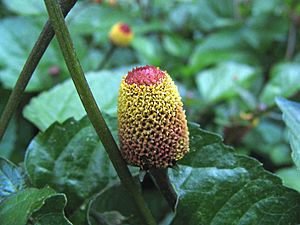Toothache plant facts for kids
Quick facts for kids Toothache plant |
|
|---|---|
 |
|
| Scientific classification | |
| Genus: |
Acmella
|
| Species: |
oleracea
|
| Synonyms | |
|
|
Acmella oleracea is a type of flowering plant in the Asteraceae family, which includes daisies and sunflowers. It has many fun common names like toothache plant, Szechuan buttons, paracress, buzz buttons, tingflowers, and electric daisy.
Scientists believe this plant originally came from Brazil. It is a small plant that grows straight up and very quickly. It has pretty gold and red flowers. The plant does not like cold weather. It can grow year after year in warmer places. The name oleracea comes from Latin and means "vegetable" or "herbal."
Contents
What is the Toothache Plant Used For?
Cooking with Acmella oleracea
People use the fresh leaves of the toothache plant in cooking. A small amount of shredded fresh leaves can add a special taste to salads. When the leaves are cooked, they lose their strong flavor. Then, you can use them like other leafy greens.
In northern Brazil, especially in the state of Pará, people use both fresh and cooked leaves in dishes like stews. They often mix the leaves with chilis and garlic. This adds flavor and important vitamins to their food.
The flower buds of the plant are very interesting. They taste a bit like grass at first. Then, they create a strong tingling or numbing feeling in your mouth. They can also make your mouth water a lot. After that, you might feel a cool sensation in your throat. These buds are known as "buzz buttons" or "electric buttons" because of this unique feeling.
Jambu Extract and Its Flavors
A strong liquid taken from the plant is called jambu oil or jambu extract. People use it to add flavor to different foods and even chewing gum. This extract is made from all parts of the plant.
Jambu extract can smell like citrus fruits, herbs, or even a bit tropical. Its taste is often described as sharp, cooling, tingling, numbing, or fizzy. A special part of the extract, called spilanthol, makes your mouth water. It also gives the plant its unique tingling taste.
How to Grow the Toothache Plant
Planting and Care Tips
This plant likes soil that drains water well. It grows best in dark soil that has a lot of natural material. If you are planting seeds outside, wait until all cold weather has passed. The seeds do not like the cold.
The seeds need direct sunlight to grow. So, do not bury them when you plant them. Just place them on top of the soil.
Traditional Uses of the Plant
Using Acmella oleracea in Folk Remedies
For a long time, people have used the toothache plant in traditional medicine. They would make a special tea or liquid from the leaves and flowers. This was used as a folk remedy for different problems.
How the Plant Helps with Pests
Natural Pest Control
Scientists have studied extracts from the toothache plant. They tested them against yellow fever mosquitoes and corn earworm moths. The spilanthol in the plant was good at killing mosquitoes. It could kill all mosquitoes at a certain amount. It also helped reduce the weight of corn earworm larvae. This shows the plant might be useful for natural pest control.
Images for kids
See also
 In Spanish: Acmella oleracea para niños
In Spanish: Acmella oleracea para niños




